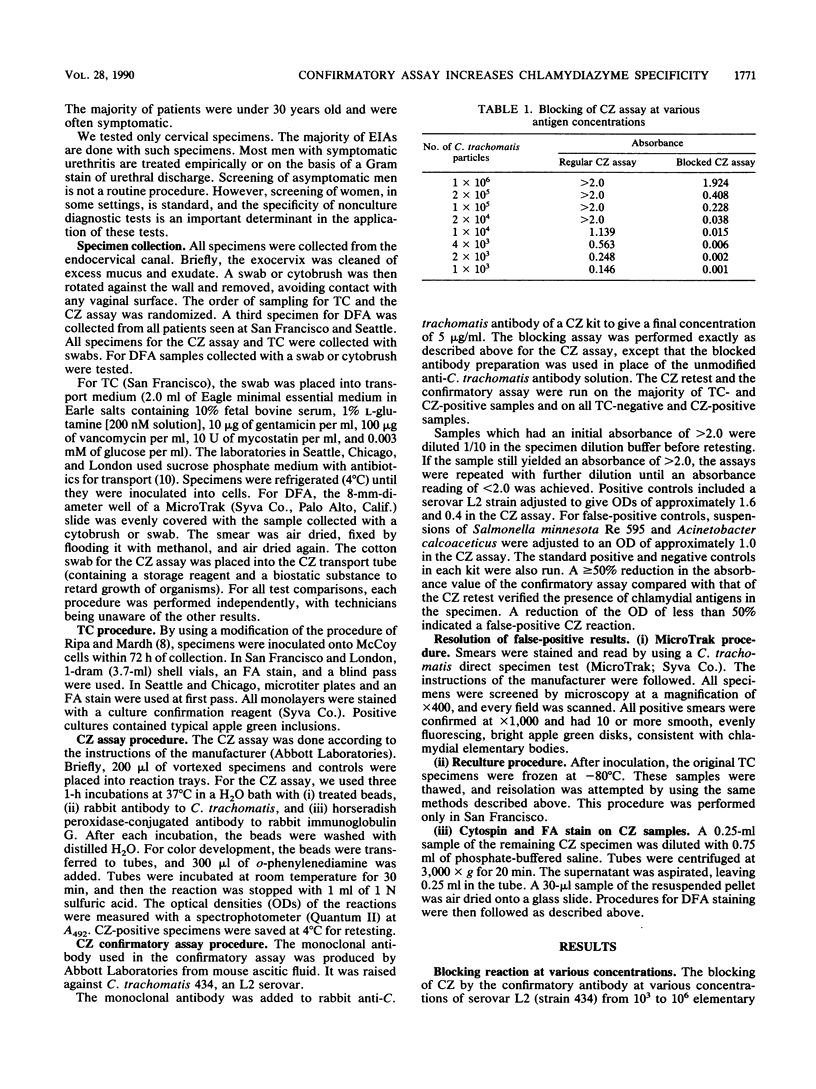Abstract
Enzyme immunoassays for the detection of chlamydial antigens are commonly used to diagnose Chlamydia trachomatis infection. As is true for all nonculture methods, the specificities of these tests are a concern. A confirmatory blocking assay (Abbott Laboratories, North Chicago, Ill.) was evaluated at four sexually transmitted disease test sites. This assay is designed to confirm true-positive Chlamydiazyme (CZ) specimens and to identify false-positive CZ reactions caused by cross-reacting bacteria. Cervical specimens were collected from 2,891 women. Chlamydia prevalence by tissue culture (TC) was 9.2% (266 of 2,891 specimens). Compared with TC, the sensitivity and specificity of CZ were 78.9% (210 of 266 specimens) and 98.2% (2,577 of 2,625 specimens), respectively. There were 48 CZ false-positive reactions. The direct fluorescent-antibody test (DFA) was positive for 31 of 48 false-positive reactions, indicating culture misses. Thus, when the standard was both TC and DFA, CZ sensitivity was 81.1% and CZ specificity was 99.3%. Of the 17 CZ-positive patients who were negative by both TC and DFA, 3 were negative on repeat CZ and 11 of 14 were identified as false positive by the confirmatory assay. The confirmatory test was positive for CZ-positive women who were positive by TC or DFA. Use of the confirmatory test, which increased the specificity to 99.9%, would increase confidence in positive CZ results and make the test more useful for screening populations with a low prevalence of C. trachomatis infection.
Full text
PDF



Selected References
These references are in PubMed. This may not be the complete list of references from this article.
- Chernesky M. A., Mahony J. B., Castriciano S., Mores M., Stewart I. O., Landis S. J., Seidelman W., Sargeant E. J., Leman C. Detection of Chlamydia trachomatis antigens by enzyme immunoassay and immunofluorescence in genital specimens from symptomatic and asymptomatic men and women. J Infect Dis. 1986 Jul;154(1):141–148. doi: 10.1093/infdis/154.1.141. [DOI] [PubMed] [Google Scholar]
- Hammerschlag M. R., Rettig P. J., Shields M. E. False positive results with the use of chlamydial antigen detection tests in the evaluation of suspected sexual abuse in children. Pediatr Infect Dis J. 1988 Jan;7(1):11–14. doi: 10.1097/00006454-198801000-00004. [DOI] [PubMed] [Google Scholar]
- Howard L. V., Coleman P. F., England B. J., Herrmann J. E. Evaluation of chlamydiazyme for the detection of genital infections caused by Chlamydia trachomatis. J Clin Microbiol. 1986 Feb;23(2):329–332. doi: 10.1128/jcm.23.2.329-332.1986. [DOI] [PMC free article] [PubMed] [Google Scholar]
- Kellogg J. A., Seiple J. W., Levisky J. S. Efficacy of duplicate genital specimens and repeated testing for confirming positive results for chlamydiazyme detection of Chlamydia trachomatis antigen. J Clin Microbiol. 1989 Jun;27(6):1218–1221. doi: 10.1128/jcm.27.6.1218-1221.1989. [DOI] [PMC free article] [PubMed] [Google Scholar]
- Lefebvre J., Laperrière H., Rousseau H., Massé R. Comparison of three techniques for detection of Chlamydia trachomatis in endocervical specimens from asymptomatic women. J Clin Microbiol. 1988 Apr;26(4):726–731. doi: 10.1128/jcm.26.4.726-731.1988. [DOI] [PMC free article] [PubMed] [Google Scholar]
- Mohanty K. C., O'Neill J. J., Hambling M. H. Comparison of enzyme immunoassays and cell culture for detecting Chlamydia trachomatis. Genitourin Med. 1986 Jun;62(3):175–176. doi: 10.1136/sti.62.3.175. [DOI] [PMC free article] [PubMed] [Google Scholar]
- Moncada J., Schachter J., Shipp M., Bolan G., Wilber J. Cytobrush in collection of cervical specimens for detection of Chlamydia trachomatis. J Clin Microbiol. 1989 Aug;27(8):1863–1866. doi: 10.1128/jcm.27.8.1863-1866.1989. [DOI] [PMC free article] [PubMed] [Google Scholar]
- Ripa K. T., Mårdh P. A. Cultivation of Chlamydia trachomatis in cycloheximide-treated mccoy cells. J Clin Microbiol. 1977 Oct;6(4):328–331. doi: 10.1128/jcm.6.4.328-331.1977. [DOI] [PMC free article] [PubMed] [Google Scholar]
- Saikku P., Puolakkainen M., Leinonen M., Nurminen M., Nissinen A. Cross-reactivity between Chlamydiazyme and Acinetobacter strains. N Engl J Med. 1986 Apr 3;314(14):922–923. doi: 10.1056/NEJM198604033141413. [DOI] [PubMed] [Google Scholar]
- Schachter J. Immunodiagnosis of sexually transmitted disease. Yale J Biol Med. 1985 Sep-Oct;58(5):443–452. [PMC free article] [PubMed] [Google Scholar]
- Schachter J., Moncada J., Dawson C. R., Sheppard J., Courtright P., Said M. E., Zaki S., Hafez S. F., Lorincz A. Nonculture methods for diagnosing chlamydial infection in patients with trachoma: a clue to the pathogenesis of the disease? J Infect Dis. 1988 Dec;158(6):1347–1352. doi: 10.1093/infdis/158.6.1347. [DOI] [PubMed] [Google Scholar]
- Schachter J. Rapid diagnosis of sexually transmitted diseases--speed has a price. Diagn Microbiol Infect Dis. 1986 Mar;4(3):185–189. doi: 10.1016/0732-8893(86)90097-0. [DOI] [PubMed] [Google Scholar]
- Schachter J., Stoner E., Moncada J. Screening for chlamydial infections in women attending family planning clinics. West J Med. 1983 Mar;138(3):375–379. [PMC free article] [PubMed] [Google Scholar]
- Smith J. W., Rogers R. E., Katz B. P., Brickler J. F., Lineback P. L., Van der Pol B., Jones R. B. Diagnosis of chlamydial infection in women attending antenatal and gynecologic clinics. J Clin Microbiol. 1987 May;25(5):868–872. doi: 10.1128/jcm.25.5.868-872.1987. [DOI] [PMC free article] [PubMed] [Google Scholar]
- Stamm W. E., Cole B. Asymptomatic Chlamydia trachomatis urethritis in men. Sex Transm Dis. 1986 Jul-Sep;13(3):163–165. doi: 10.1097/00007435-198607000-00010. [DOI] [PubMed] [Google Scholar]


